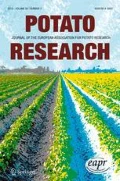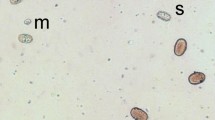Summary
-
1.
Crossing experiments betweenS. polyadenium, either as pistillate or staminate parent and several tuberousSolanum forms and species were carried out by use of several crossing methods known to favour difficult hybridizations.
-
2.
All the crossings failed and only parthenocarpic berries containing no seeds were obtained.
-
3.
The negative results are discussed in view of the findings of other authors.
Zusammenfassung
Die Vorteile der Kartoffelzüchtung auf diploidem Niveau werden von verschiedenen Autoren zusammenfassend dargestellt.
Praktische Sortenzüchtung nach der Inzucht-Heterosismethode kann aber aufgrund von Inkompatibilitäten heute immer noch nicht durchgeführt werden. Deshalb wurde versucht, die inS. polyadenium vorhandene Selbstkompatibilität in diploides, selbstinkompatibles Züchtungsmaterial überzuführen. Alle Kreuzungen zwischenS. polyadenium und verschiedenen diploiden Arten (vergl. Tabelle I) blieben trotz Anwendung verschiedener Kreuzungshilfsmittel und unabhängig von der Kreuzungsrichtung erfolglos (Tabellen 2, 3 und 4). Pollenkeimexperimente auf künstlichen Nährmedien mit und ohne Zusatz vonS. polyadenium-Griffelmaterial zeigten keine signifikanten Unterschiede. Es wird deshalb vermutet, dass die Kreuzungsinkompatibilität zwischenS. polyadenium und andern Spezies an die lebende Zelle gebunden ist. Die Ergebnisse stimmen im allgemeinen mit der Literatur überein.
Résumé
Les avantages de la sélection de la pomme de terre au niveau diploïde ont été passés en revue par divers auteurs.
La sélection pratique suivant la méthode autofécondation—heterosis n'a pas encore pu être appliquée en raison des incompatibilités. C'est pourquoi on a tenté de transférer dans le matériel de sélection diploïde autoincompatible la compatibilité existant dansS. polyadenium. Tous les croisements entreS. polyadenium et diverses espèces diploïdes (voir tableau 1) ont échoué quel que soit le sens du croisement et malgré le recours à divers traitements visant à favoriser la fécondation (voir tableaux 2, 3 et 4). Des expériences de germination du pollen sur milieu artificiel avec ou sans adjonction de broyat de styles deS. polyadenium n'ont pas montré de différences significatives. De ce fait, on suppose que l'incompatibilité entreS. polyadenium et d'autres espèces est liée aux cellules vivantes. Dans l'ensemble, les résultats concordent avec les données de la littérature.
Similar content being viewed by others
References
Abdalla, M. M. F., 1970 Inbreeding, heterosis, fertility, plasmon differentiation andPhytophthora resistance inSolanum verrucosum Schlechtd., and some interspecific crosses inSolanum.Agric. Res. Rep. 748. Pudoc, Wageningen, the Netherlands.
Bukasov, S. M. & A. Y. Kameraz, 1959. The basis of selection of potatoes. State Publisher of Agricultural Literature, Moscow and Leningrad (c. f. Graham & Dionne, 1961).
Choudhuri, H. C., 1944. Cytological and genetical studies in the genusSolanum. II. Wild and native cultivated ‘diploid’ potatoes.Trans. Roy. Soc. Edinb. 61:199–219.
Dionne, L. A., 1958. A survey of methods for overcoming cross-incompatibility between certain series of the genusSolanum.Am. Potato J. 35:422–423.
Dionne, L. A., 1961. Mechanisms of interspecific incompatibility in tuberbearing Solanum species.Am. Potato J. 38:73–77.
Frimmel, G., 1956. Ueber Hormone in Kartoffelpollen.Bodenkultur 8:349–351.
Graham, K. M. & L. A. Dionne, 1961. Crossability relationship of certain diploid Mexican Solanum species.Canad. J. Genet. Cytol. 3: 121–127.
Hawkes, J. G., 1958. Significance of wild species and primitive forms for potato breeding.Euphytica 7:257–270.
Hougas, R. W. & S. J. Peloquin, 1958. The potential of potato haploids in breeding and genetic research.Am. Potato J. 35:701–707.
Hougas, R. W. & S. J. Peloquin, 1960a The national potato breeding program 1958. Genetics and cytogenetics of the tuber bearingSolanum species.Pl. Breed. Abstr. 30:2820.
Hougas, R. W. & S. J. Peloquin, 1960b. Initial evidence concerning the feasibility of potato breeding at the diploid level.Am. Potato J. 37:348.
Kanta, K. 1960. Intra-ovarian pollination inPapaver rhoeas L.Nature Lond. 188:683–684.
Kanta, K. & P. Maheshwari, 1963. Intra-ovarian pollination in some Papaveraceae.Phytomorphology 13:215–229.
Lewis, D. & L. K. Crowe, 1958. Unilaterial interspecific incompatibility in flowering plants.Heredity 12:233–256.
Maag, H. P., 1975. Ueber Möglichkeiten der Herstellung von selbstkompatiblemSolanum-Material (2x) sowie Beurteilung der Verwendungsfähigkeit diploider Formen in der Kartoffelzüchtung. Diss. ETH-Zürich.
Maheshwari, P. & K. Kanta, 1961. Intra-ovarian pollination inEscholzia california Cham.,Argemone mexicana L. andA. ochrolenca Sweet.Nature, Lond. 191, 304.
Payacyk, V., 1965. Some research work on potatoes.Pl. Breed. Abstr. 35:6711.
Peloquin, S. J. & R. W. Hougas, 1966. Hybrids between haploids of the cultivated potato and 24-chromosomeSolanum species.Pl. Breed. Abstr. 36:4333.
Peloquin, S. J. et al., 1966. Haploidy as a new approach to the cytogenetics and breeding ofSolanum tuberosum. In: R. Riley & K. R. Lewis (Ed.), Chromosome manupulation and plant genetics, p. 21–28. Oliver and Boyd, Edinburgh and London.
Propach, U., 1940. Cytogenetische Untersuchungen in der GattungSolanum sect. Tuberarium. V. Diploide Artbastarde.Z. Vererbehre 78:115–128.
Ross, H., 1963. Ueber wissenschaftliche Grundlagen der Züchtung der Kartoffel.Mitt. Max-Planck-Ges., Heft 3:175–193.
Rust, K., 1972. Untersuchungen über die Kreuzbarkeit vonS. polyadenium mit diploidenSolanum-Wildarten. Diplomarbeit am Institut für Pflanzenbau der ETH-Zürich. Unpublished.
Stelzner, G., 1949. Ueber die Erzeugung von Bastarden vonSolanum polyadenium (Greenm.) mit Kulturkartoffelsorten und ihre Resistenzmerkmale.Züchter 19:331–339.
Swaminathan, M. S. 1951. Notes on induced polyploids in the tuber-bearingSolanum species and their crossability withSolanum tuberosum.Am. Potato J. 28:472–489.
Swaminathan, M. S., 1955. Overcoming cross-incompatibility among some Mexican diploid species ofSolanum.Nature, Lond. 176:887.
Toxopeus, H. J., 1964. Treasure-digging for blight resistance in potatoes.Euphytica 13:206–222.
Author information
Authors and Affiliations
Rights and permissions
About this article
Cite this article
Maag, H.P., Keller, E.R. Studies on the possibility of transferring the self-compatibility complex of self-compatibleSolanum species to self-incompatible diploid breeding stocks. 1.S. polyadenium as the source of self-compatibility. Potato Res 19, 313–322 (1976). https://doi.org/10.1007/BF02359850
Accepted:
Issue Date:
DOI: https://doi.org/10.1007/BF02359850



